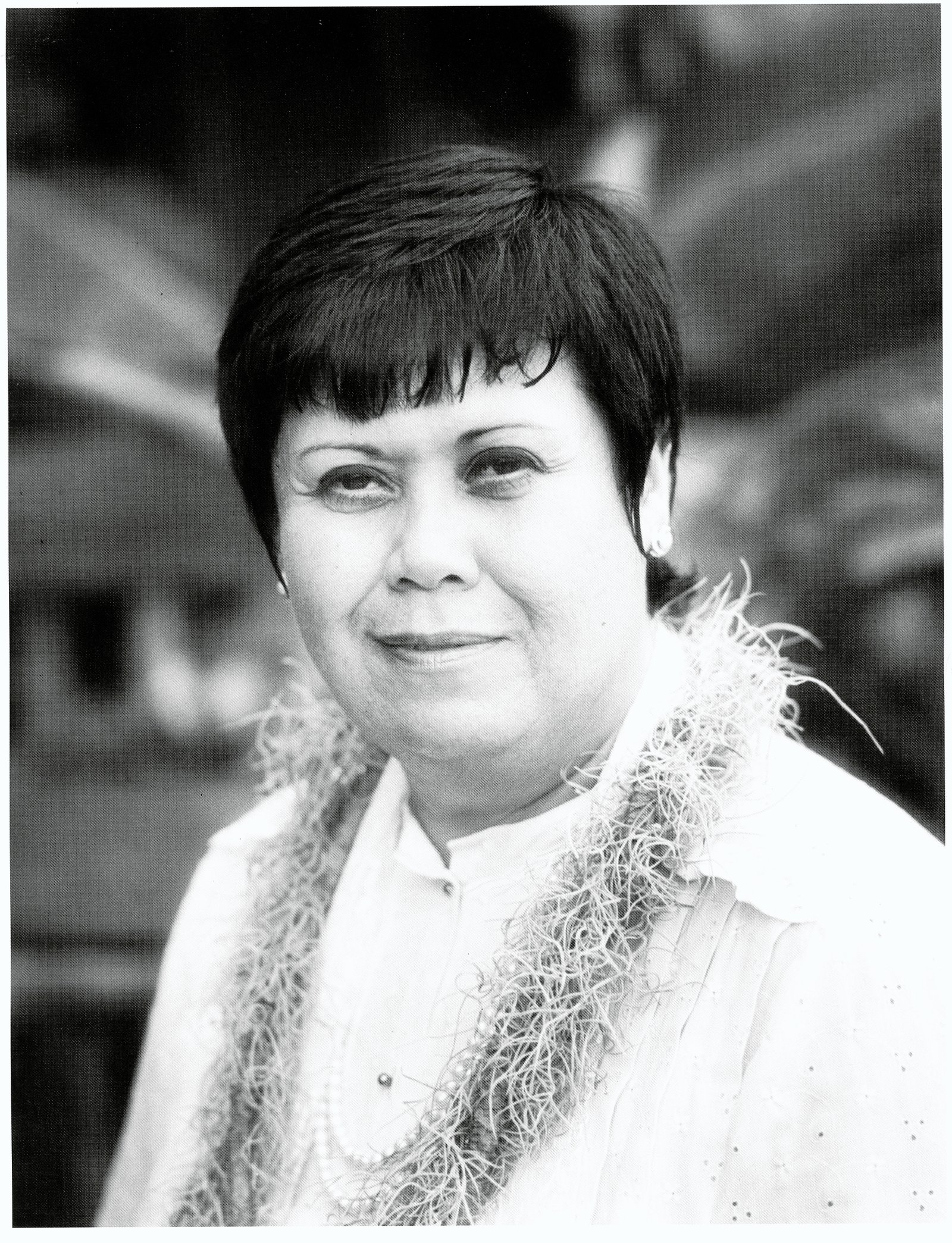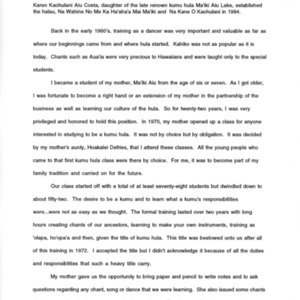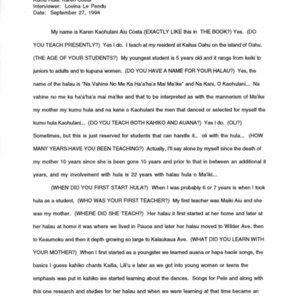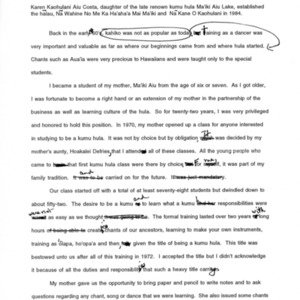Karen Kaohulani Aiu Costa
Title
Karen Kaohulani Aiu Costa
Subject
Nā Kumu Hula Karen Kaohulani Aiu Costa - Nānā I Nā Loea Hula Volume 2 Page 35
Description
Karen Costa, daughter of the late renowned kumu hula Māʻiki Aiu Lake, established Nā Wahine No Me Ka Ha‘aha‘a Mai Māʻiki and Nā Kāne O Kaohulani in 1984.
Back in the early 1960s training as a dancer was very important and valuable as far as where our beginnings came from and where hula started. Kahiko was not as popular as it is today. Chants such as “‘Au‘a‘la” were very precious to Hawaiians and were taught only to the special students.
I became a student of my mother Māʻiki Aiu from the age of six or seven. As I got older I was fortunate to become an extension of my mother in the running of the hālau business as well as learning our culture of the hula. For twenty-two years I was very privileged to hold this position.
In 1970 my mother opened up a class for anyone interested in studying to he a kumu hula. It was decided by my mother’s aunty Hoakalei Defries that I attend these classes. All the young people who came to that first kumu hula class were there by choice. For me it was an obligation. It was meant for me to carry on the family tradition into the future.
Our class started off with a total of at least seventy-eight students but dwindled down to about fifty-two. The desire to be a kumu and to learn what a kumu’s responsibilities are were not as easy as we thought. The formal training lasted over two years with long hours learning chants of our ancestors, making our own instruments, and training as ‘ōlapa and ho‘opa‘a. Only then were we given the title of kumu hula. This title was bestowed onto us after all of this training in 1972. I accepted the title but I didn’t acknowledge it because of all the duties and responsibilities that such a gift carried.
My mother gave us the opportunity to write notes and to ask questions regarding any chant, song or dance that we were learning. She also issued some chants that we never heard of on paper to make it easy for us. Tūtū Kawena Pukui encouraged her to satisfy the need for paper and pencil because when we went home, we would be totally lost if we didn’t have anyone who spoke the language. We would be frustrated and lose interest in learning. It would be more damaging not to have something to fall back on.
I have had the opportunity during those twenty-two years with my mother of visiting and learning from many elders. Today many of them are gone like Aunty Alice Nāmakelua, Vicky Iʻi Rodrigues, Uncle Bill AliʻiIoa Lincoln and Tūtū Kawena Pukui. Today I am fortunate to have caring teachers such as Aunty Malia Craver, Kaʻupena Wong, Namaka Bacon and my godmother Kekauʻilani Kalama.
As I got older and hopefully wiser, I experienced things and saw the love of people who came to me and believed in me and my teaching. They told me that I really had a lot to share. My interpretation of kumu hula has always been what I saw in my mother. She was so enlightening, full of love, and she had so much to give. I didn’t think I was that kind of a person. But the people looked to me for all of the same things that they saw in my mother. Today I share the knowledge that my mother’s hula masters left with her and she has left with me. Now I leave it with all of you.
As a teacher my mother was strict but there was also love and concern. To me she was a master in all that she did. She appealed to the young because she made hula exciting. She wasn’t selfish with her haumāna and she was always forever giving. All of these things made me look up to her. Hopefully all these qualities are what I as a kumu hula can someday leave to my haumāna.
In time I visualize hula will come full circle and we will return to that which was the most important. We will go back to the beginnings, to the basics, to our ancestors, and that will be vital to our survival. We do have elders; we do have beginnings; we do have grass roots; and where we all come from and the source of the elders is there. Without the source we don’t have much of a future.
“My interpretation of kumu hula has always been what I saw in my mother. She was so enlightening, full oj love, and she had so much to give.”
Back in the early 1960s training as a dancer was very important and valuable as far as where our beginnings came from and where hula started. Kahiko was not as popular as it is today. Chants such as “‘Au‘a‘la” were very precious to Hawaiians and were taught only to the special students.
I became a student of my mother Māʻiki Aiu from the age of six or seven. As I got older I was fortunate to become an extension of my mother in the running of the hālau business as well as learning our culture of the hula. For twenty-two years I was very privileged to hold this position.
In 1970 my mother opened up a class for anyone interested in studying to he a kumu hula. It was decided by my mother’s aunty Hoakalei Defries that I attend these classes. All the young people who came to that first kumu hula class were there by choice. For me it was an obligation. It was meant for me to carry on the family tradition into the future.
Our class started off with a total of at least seventy-eight students but dwindled down to about fifty-two. The desire to be a kumu and to learn what a kumu’s responsibilities are were not as easy as we thought. The formal training lasted over two years with long hours learning chants of our ancestors, making our own instruments, and training as ‘ōlapa and ho‘opa‘a. Only then were we given the title of kumu hula. This title was bestowed onto us after all of this training in 1972. I accepted the title but I didn’t acknowledge it because of all the duties and responsibilities that such a gift carried.
My mother gave us the opportunity to write notes and to ask questions regarding any chant, song or dance that we were learning. She also issued some chants that we never heard of on paper to make it easy for us. Tūtū Kawena Pukui encouraged her to satisfy the need for paper and pencil because when we went home, we would be totally lost if we didn’t have anyone who spoke the language. We would be frustrated and lose interest in learning. It would be more damaging not to have something to fall back on.
I have had the opportunity during those twenty-two years with my mother of visiting and learning from many elders. Today many of them are gone like Aunty Alice Nāmakelua, Vicky Iʻi Rodrigues, Uncle Bill AliʻiIoa Lincoln and Tūtū Kawena Pukui. Today I am fortunate to have caring teachers such as Aunty Malia Craver, Kaʻupena Wong, Namaka Bacon and my godmother Kekauʻilani Kalama.
As I got older and hopefully wiser, I experienced things and saw the love of people who came to me and believed in me and my teaching. They told me that I really had a lot to share. My interpretation of kumu hula has always been what I saw in my mother. She was so enlightening, full of love, and she had so much to give. I didn’t think I was that kind of a person. But the people looked to me for all of the same things that they saw in my mother. Today I share the knowledge that my mother’s hula masters left with her and she has left with me. Now I leave it with all of you.
As a teacher my mother was strict but there was also love and concern. To me she was a master in all that she did. She appealed to the young because she made hula exciting. She wasn’t selfish with her haumāna and she was always forever giving. All of these things made me look up to her. Hopefully all these qualities are what I as a kumu hula can someday leave to my haumāna.
In time I visualize hula will come full circle and we will return to that which was the most important. We will go back to the beginnings, to the basics, to our ancestors, and that will be vital to our survival. We do have elders; we do have beginnings; we do have grass roots; and where we all come from and the source of the elders is there. Without the source we don’t have much of a future.
“My interpretation of kumu hula has always been what I saw in my mother. She was so enlightening, full oj love, and she had so much to give.”
Citation
“Karen Kaohulani Aiu Costa,” Nā Kumu Hula Archive, accessed August 25, 2025, https://nakumuhula.org/archive/items/show/115.








